First look at Apa Khabar Orang Kampung
It was a 10-day shoot: 16-25 August. The location was a village in Sukhrin, Narathiwat, South Thailand, home of retired members of the 10th Regiment, the only Malay-Muslim division of the Communist Party of Malaya.
140 families live there now. Fewer than 20 people were those born in Malaya before the regiment began its 'Long March' across the Thai border in the early 1950s. They would not see Malaya/Malaysia again for five decades. We spoke to all of these pioneers who happened to be there, and a few more besides.
Apa Khabar Orang Kampung will look and sound very different from Lelaki Komunis Terakhir. For reasons that will, I hope, be obvious when I explain later, the English title is not a direct translation but rather Village Radio.
Over 3,000 stills were taken by the intrepid Danny Lim. This is a sample. We heard many stories there; these pictures indicate some of them. As for the complete picture, this will only emerge when we start editing in a few days.

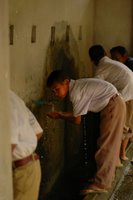
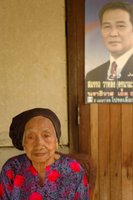
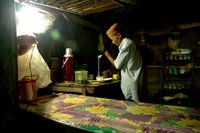
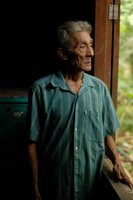
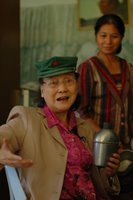
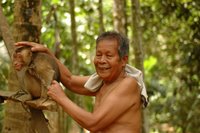

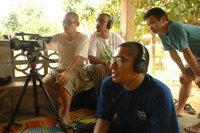

Not to be outdone, our Director of Photography Albert Hue, who also took hundreds of stills, has blogged them here. Now let's see which pompous blowhard dares criticise his 'cinematography'!
140 families live there now. Fewer than 20 people were those born in Malaya before the regiment began its 'Long March' across the Thai border in the early 1950s. They would not see Malaya/Malaysia again for five decades. We spoke to all of these pioneers who happened to be there, and a few more besides.
Apa Khabar Orang Kampung will look and sound very different from Lelaki Komunis Terakhir. For reasons that will, I hope, be obvious when I explain later, the English title is not a direct translation but rather Village Radio.
Over 3,000 stills were taken by the intrepid Danny Lim. This is a sample. We heard many stories there; these pictures indicate some of them. As for the complete picture, this will only emerge when we start editing in a few days.










Not to be outdone, our Director of Photography Albert Hue, who also took hundreds of stills, has blogged them here. Now let's see which pompous blowhard dares criticise his 'cinematography'!
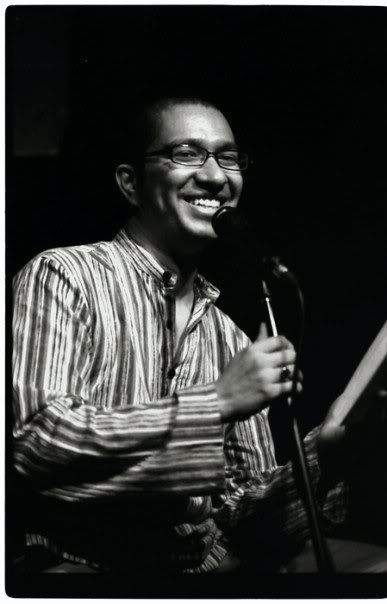

9 Comments:
PAS: Communist party helped secure Merdeka
Aug 29, 06 12:31pm
malaysiakini.com
History cannot ignore the fact that the Communist Party of Malaya (CPM) had also played a role in fighting for the independence of this country, said a PAS think-tank.
In a ground-breaking article published in the party organ Harakahdaily.net on Sunday, the PAS research centre said CPM had been active in its campaign for independence since its formation in May 1930.
“During the Japanese rule, (CPM secretary-general) Chin Peng (photo) and his comrades were one of the bravest groups to have fought against the Japanese.
“They lived in the middle of the jungle, slept on the ground with only the sky as their roof in order to battle the Japanese and to search for true independence. Is it fair to ignore their contribution now?”
The centre said CPM’s struggle did not end with the Japanese as they also waged an armed struggle against the British for independence.
It said while CPM wanted to form a communist state - which was rejected by both the Malay community and Islam - it is however wrong not to acknowledge the party’s contribution to the nation's quest for independence.
Include all who fought
In view of this, the centre said it is vital that all historical facts pertaining to independence be included.
The struggle should not be confined to only those at the negotiation table, but also encompass those who were willing to give up their lives to fight for independence, it added.
“Before Tunku Abdul Rahman chanted ‘Merdeka’ on Aug 31, 1957, the call was already resonating, and many historical episodes were being played not only by Umno and the Alliance.
"CPM and banned Malay nationalist parties took up arms against the British. Abdullah CD, Rashid Mydin, Shamsiah Fakeh and Musa Ahmad were among the leaders who fought for independence."
CPM gave up arms following its peace treaty with the governments of Malaysia and Thailand, signed on Dec 2, 1989 at the southern Thai city of Haadyai.
Chin Peng, who is currently living in Thailand, is embroiled in a legal struggle with the Malaysian government over his bid to return to this country.
Meanwhile, the PAS research centre also said that history showed the existence of Malay nationalist parties which were well ahead of Umno in the struggle for independence.
These were Persatuan Kebangsaan Melayu Malaya (PKMM), Angkatan Pemuda Insaf (API), Angkatan Wanita Sedar (Awas), Baris Tani Se-Malaya (Batas) and the Majlis Tertinggi Se-Malaya (Mata).
The centre said Merdeka celebrations would have a greater meaning when the people learn and accept the true picture of our independence struggle.
When this happens, it added, the government would no longer have to repeatedly remind the people of the Merdeka celebrations as “it (the celebrations) would belong to all Malaysians”.
THE REBEL OF PASIR PUTIH
by Amir Muhammad
31 August 2006.
Since today is such an auspicious day that will be known throughout history as The Third Day After The Wedding, I will take a break from the usual format of this column to talk about … a book.
Yes, a book! If the results of a recent survey are to be believed, the average Malaysian reads only two books a year. (But we apparently read and respond to many surveys). I am only halfway through this book I am about to discuss, so if I were an average Malaysian I would have fulfilled 25% of my annual quota already.
The book is a new one, To’ Janggut: Legends, Histories and Perceptions of the 1915 Rebellion in Kelantan by Cheah Boon Kheng, the retired Professor of History of Universiti Sains Malaysia, It is published by the National University of Singapore which might explain its rather frightening price: RM75 for a slim paperback, and it doesn’t even come with colour photographs or a CD-Rom!
I have never met Professor Cheah although I have read many articles by him. I tried to interview him last year for a documentary. He politely but firmly declined. The fact that he seemed publicity-shy in an era where everyone and his ex-fiancee wants to demand their 15 minutes of karaoke time was, of course, a source of wonder – and some irritation. “Doesn’t he want to be famous?” I wondered. The documentary ended up getting banned and lots of attention, but that’s a different story.
Anyway, his new book is about To’ Janggut, the Kelantanese man who has been the subject of many legends. For starters, he was supposed to be kebal (invulnerable), a belief somewhat revised when British-employed forces managed to gun him down in Pasir Putih. Although the bare facts of his rebellion in seem to be a matter of public record, there are still contesting accounts as to why he did what he did.
Kelantan in 1915 had only been under the British for a few short years. To the locals, “foreigners” would include not only the British but Malays from other states, so strong was the sense of regional identity.
In April and May of that year, several attacks were made by To’ Janggut and his followers against authority, and troops had to be dispatched from Singapore to quell the situation. Was his revolt a simple protest against new systems of taxation or could it be read as an early form of anti-colonial uprising? Did he initially get the tacit approval of the Kelantan Sultan, whose kin had to pay taxes for the first time, and was this approval revoked for reasons of political convenience? Did the earlier murder of his father and elder brother by locals connected with State nobility fuel his wrath? And did any of this have to do with jihad (holy war) in support of Turkey during World War 1?
The gruesome climax of his revolt: To’ Janggut was killed and his corpse hanged upside down and displayed to the public for thousands to see. There are British photographs of a corpse displayed in such a manner; it is most likely To’ Janggut, although the photos were uncaptioned when unearthed in libraries. Although most accounts have the corpse displayed for an hour in one location, other accounts have him taken to two places or hanged for three days.
So there you have it. A relatively isolated incident in the annals of early British occupation has gripped the imagination, of successive story-tellers although the reasons for this endurance shifts in tune with contemporary concerns. History is only useful when it is in the present tense.
Cheah analyses not only official British documents and newspaper accounts but Malay books that have been written on the incident, as well as Kelantanese oral histories from people in the area.
Interestingly enough, the earliest folk accounts have it that the rebellion was, at least in part, aimed at the Kelantan Sultan and aristocracy who were perceived to have sold out the interests of the locals to the newly-established colonial power. The title of the 1955 book by the Kelantan writer Yahya Abdullah is, quite tellingly, Peperangan To’ Janggut, atau Balasan Derhaka. Telling because ‘derhaka’ denotes rebellion against the Sultan; rebellion against the British would not require such a word.
This book has it that To’ Janggut’s father Panglima Monas raped his master’s concubine because this lord had ignored appeals to avenge the murder of his son (To’ Janggut’s brother) at the hands of a retainer of the Sultan. Panglima Monas was then ordered killed and the cycle of vengeance continued. It is a thrilling story that is also “a subtle critique against Malay feudal society and its values.”
A subsequent revision of the book just two years later was retitled Riwayat Hidup To’ Janggut dan Peperangannya di Kelantan. This version however eliminates the anti-feudalist critique of To’ Janggut’s derhaka or lese-majeste. There are no criticisms of the Sultan or aristocracy. It starts the process of recasting To’ Janggut as an anti-British proto-nationalist, and this is the version that is continually retold in history books.
The more recent historical dissertations even claim he is a jihad warrior expressing solidarity with Turkey then in the midst of World War 1, although there is no evidence that the rebels had ever invoked Islamic sentiments.
The reluctance of local, principally Malay Muslim, scholars to examine the anti-feudalist nature of To’ Janggut’s rebellion can be attributed to the sacrosanct image that our rulers enjoyed until the landmark 1993 constitutional amendment that removed their immunity from criminal charges. So the earliest folk accounts of the rebellion could be seen as running counter to both the British and feudal Malay establishments.
National Laureate S Othman Kelantan also narrates how the story of To’ Janggut was such a controversial one decades after the incident that a play that he wrote about it was refused permission to stage in his native state.
Cheah is interested not only in what happened but why different accounts have emerged. Not to descend into a post-modern relativist mush but to respect and gently probe the social context in which each contingent version came to flourish.
Reading his book made History (a subject we all hated in school, of course) so much more interesting. I couldn’t help thinking things like: Of the thousands of people who marched against the new British-imposed land taxes, how many had land to be taxed to begin with? And how many were doing the bidding of the gentry, most of whom would not have to pay for their fiscal dissatisfaction in blood? How complicit was the feudal elite in crushing the scattered and sporadic anti-British protests that erupted in colonial Malaya throughout the early 20th century? Do we not find it now ironic that elements of the feudal elite would then be considered as symbols of resistance when it suited them?
It would be a boring country whose history can be told in a linear and unambiguous fashion. Although some recent events may lead us to despair at the hegemonic tendencies of national historiography, we can take solace in the fact that things don’t have to be boring. Although Malaysians don’t like to read, so many of our multiple histories are in print, waiting to be discovered. So to celebrate your sense of Independence, increase your reading to … three books a year. And make this one of them.
***
Ex CPM Leader Rashid Maidin Dies
BANGKOK, Sept 1 (Bernama) -- Former Communist Party of Malaya (CPM) leader, Rashid Maidin died this morning, a Thai army spokesman said.
He said Rashid died at his daughter's house at Sisakoin, Narathiwat and will be buried there in the afternoon.
-- BERNAMA
For more accurate news and profiles of Rashid Maidin, please visit http://jameswongwingon-online-blogspot.com
wah,
teruja
The English title has since been changed (or extended) to Village People Radio Show. Harap maklum.
Hi all..my name is Adlan aka Boy Ipoh. I'm in the search of my old fellow skateboard friends. I run a skate web with an old friend called SkateMalaysia (www.skatemalaysia.com) and we are trying to gather infos of early skateboard scene of photos, flyers, etc. Albert Hue is one of our old friend and we wish to contact him. Last thing we remembered he is in a hip hop group called Krash Kourse. Can contact me here at : boyipoh@skatemalaysia.com
Thanks
http://www.imandarmedia.com/2017/01/health-news_10.html
We're looking for kidney donors for the sum of $450,000,00 Call or Whatsapp Dr. Donya Hockett for more details:
Mobile: Whatsapp 917418483326
What-sup 917418483326
Email: customercareunitplc@gmail.com
Post a Comment
<< Home